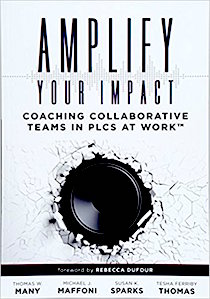Coaching PLCs to Grow as Collaborative Teams
Amplify Your Impact: Coaching Collaborative Teams in PLCs at Work
By Thomas W. Many, Michael J. Maffoni, Susan K. Sparks, and Tesha Ferriby Thomas
(Solution Tree, 2018 – Learn more)

Teaching students how to collaborate effectively is one of my primary goals as a teacher. Each year, I present them with research showing why collaboration is so important and how it can improve their learning as I teach them the norms of teamwork. Collaborative teamwork in my classroom isn’t something that just happens; it is a skill learned and practiced daily.

To improve the effectiveness of PLCs, the four authors of Amplify Your Impact have created a framework for coaches to use to guide teachers in practicing effective teamwork.
Three Cornerstones of Collaboration
Nearly every teacher has seen the difference in classroom results that comes from being a part of an effective PLC versus an ineffective one. While one teacher once told me that their former principal referred to PLCs as nothing but “professional ladies chatting,” I personally have been a part of some wonderful PLCs that have transformed my teaching.
According to Amplify Your Impact, three things must be present in a school for PLCs to be effective:
- Clarity
- Feedback
- Support
Just like the ways in which we teach students the norms of collaboration, handling conflict, and setting goals, schools need to communicate with teacher teams about their expectations. The authors urge that for PLCs and teacher collaboration to occur, “time alone is not enough” (1).
To aid in facilitating this, the book is organized into three sections dealing with creating a coaching framework, acting upon it, and evaluating examples.
Part One: Collaboration and Coaching
When people read about the clarity, feedback, and support necessary to create an effective PLC, one of their first thoughts might be: “My school doesn’t have the resources for this!”
Amplify Your Impact maintains that people who use the framework the authors provide “should not be limited to individuals whose job descriptions include the word ‘coach’” (5). They believe that any educator, from colleagues to principals, can provide coaching, and that coaching roles are fluid and can change over time based on teacher needs.
This section of the book provides support for all professionals looking to improve their PLC interactions in several ways. First, it explains the difference between coaching individual teachers versus coaching teams to work together. Then, it describes how to coach teams to create SMART goals and focus on data-driven results.
Finally, it details the four critical questions that PLCs need to ask, which are reminiscent of the backwards design questions presented in in Wiggins & Tighe’s Understanding by Design. Anyone who wants to act as a coach for a PLC can begin by using the four questions to support results-driven conversations.
Part Two: Clarity, Feedback and Support
Part Two is designed to assist people who want to strengthen their PLCs by focusing on clarity, feedback, and support. This section of the book is especially helpful to administrators and district-level leaders who want to begin or revamp the PLC process in their schools.
Part Two focuses primarily on what the book calls a “strategy implementation guide” (48), which teachers should put together in groups. According to the authors, when teachers themselves discuss and create a strategy implementation guide together, they have more buy-in and understand better when their PLCs are performing at proficient, above proficient, and below proficient levels.
I have already recommended sections of Part Two to my own PLC so that we can use the guidelines there to create our own norms and anchor statements with the goal of improving our PLC conversations. We are working together through several of the handouts provided in this section of the book, and they have fostered useful conversations.
In Part Two educators will also find helpful feedback for navigating coaching roles and how to transition themselves from collaborator to guide and back again, as PLC teams’ needs vary and change.
Part Three: Example Scenarios
The final chapter of the book details several examples of ineffective versus effective PLCs at different schools. This part was especially helpful for me as a member of a PLC because I could point out times when my own PLC has fit both scenarios.
Looking at the examples, I was able to receive direct coaching feedback from the book to help guide me and my team toward better PLC sessions. In this way, the book both coached me and modeled how I can coach other teachers in the future.
Overall, I would recommend this book to any educator who wants to improve the ways in which they work together with others. The book references and explains important research, details the whys and hows of improving collaboration, and provides a practical and usable basis of knowledge that any teacher, administrator, or instructional coach can use daily.
Laura Cockman teaches 7th and 8th grade language arts and yearbook in Nashville, Tennessee. She is a firm believer in the power of storytelling and collaboration. Connect with her at logicoflaura.com.


































